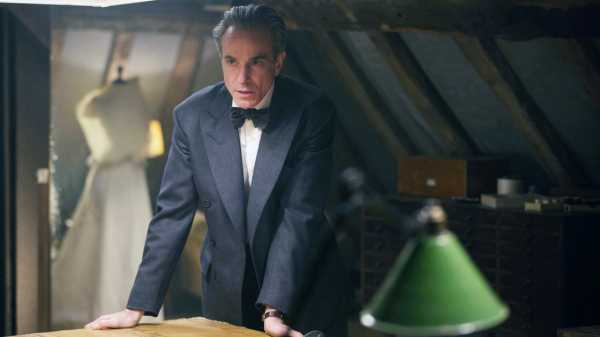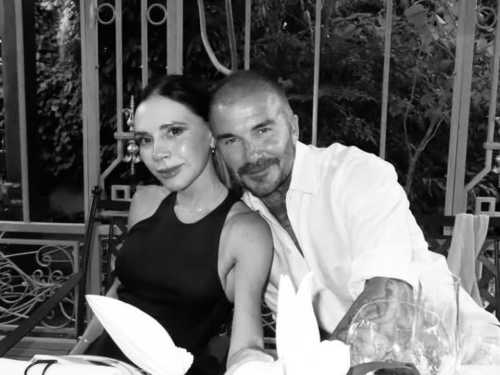
The first glimpse the audience gets of Reynolds Woodcock in “Phantom
Thread” is not as we will come to know him, armored in ruthless grace,
but as a fragile man. On a stool, wearing a white shirt, he slides red
socks up his thin legs the way that a child might. We see Woodcock’s
shoulders twitch a little, and the little angry jerks of the fabric. We
watch as he combs his hair, and approaches the mirror and snips the
hairs from his nostrils. He snips, pauses, considers, snips again. It’s
an almost vulgar display of force and detail, and one comes to
understand that this is a rare intrusion into the fretful energy that
stirs beneath Woodcock’s polished, public persona. This is not the
effortless cool of an aesthete but the white-knuckled effort of someone
trying desperately to hold onto his sense of self. “Phantom Thread”
exposes Woodcock’s personal style as not merely a disguise but an
attempted curative for his febrile self.
Written and directed by Paul Thomas Anderson, the film tells the story
of Woodcock, a postwar English designer (played by Daniel Day-Lewis),
and his courtship of a young woman named Alma (played by Vicky Krieps,
in a star-making role), as their relationship evolves into one of vivid
obsession, stunning reversals, and a scintillating collision of wills.
“Phantom Thread” has already collected a chest of awards, and it’s
nominated for six Oscars: Best Picture, Best Director, Best Actor, Best
Supporting Actress, Best Original Score, and, most important, Best
Costume Design. At its finest moments, “Phantom Thread” shows the power
that costumes impart to the depth and feeling of a story.
There is a monastic air in the House of Woodcock, and not merely because
of its astringent immaculacy. In the workroom, the seamstresses don
their white chore coats and set about the task of fabricating Woodcock’s
designs. They walk on hard, black heels from table to table, taking
measurements, aligning muslin, cutting fabric. They work with the quiet
piety of nuns in a religious order. Woodcock drifts among them in his
own chore coat, hands behind his back, peering down his nose and through
his glasses. Everyone is adorned in the same severe lines, the same
starched, brilliant white. Utility and simplicity are a single unit.
Then Woodcock flees the city for his country home. Here, he turns into a
bit of a rustic in dark, earthy knits. Woodcock stops for breakfast, and
Alma literally stumbles into the frame, drawing his attention with a
clatter. He’s wearing a casual sport coat in plaid and a dark, heavy
shirt left unbuttoned at the neck with a green tartan ascot. It’s a
sharp break from the dark-gray suit and the lavender bow tie he wore in
a preceding dinner scene in the city. Alma, like the other waitresses,
is wearing a red dress under a white apron, and this, too, is a
departure from the city; women aren’t wreathed in black and sombre
tones. There is a hint of friction as they test each other: Woodcock
delivers a comically long list of food and then snatches the order slip;
Alma delivers the order in full with a wry smile and says, “For the
hungry boy.”
Later, they go to dinner and return to Woodcock’s country home, where
their flirtation deepens. By the fire, Woodcock tells Alma in cryptic
fragments about his family, his mother, his sister, his past. We have
come to expect this from him—the chiselled, aphoristic anecdote, speech
that is both direct and elliptical. (In an earlier scene, Woodcock
murmurs about unsettled feelings and ghostly impressions to his sister
Cyril.) Silhouetted by the fire, Woodcock wears his charcoal
double-breasted suit with a whimsical but very grave bow tie in dark
green tartan. Alma asks Woodcock why he is not married and Woodcock
explains that marriage would only make him deceitful. Alma then says,
“You sound so sure of things.” Woodcock visibly tenses. “I’m sure of
that,” he says.

Further Reading
New Yorker writers on the 2018 Academy Awards.
Instead of the careless confidence one might expect, the line is
delivered with a flinch, a torrent of frustration at Alma for
questioning the firmament of his life. Alma replies, “I think you are
only acting strong.” She smiles—her dress is red again, with prim little
buttons right up the collar. Woodcock relaxes, laughs a little. He’s
been caught out. For a few moments, he reverts to the boyish, uncertain
figure whom we glimpsed in the earliest parts of the film. It’s an
arresting image; the country is the place where Woodcock is supposed to
be at his most comfortable. It’s his home. It’s his fire. Alma is there
by his invitation. He is dressed impeccably. Yet the bow tie comes to
seem a little sad, a little silly; Woodcock’s effort to dress himself so
sharply begin to resemble the efforts of an insecure man desperate to
compensate for something.
One of the great thrills of “Phantom Thread” is the way that it lingers
on the details of style. The quirks of a wardrobe become more, not less,
remarkable under this sustained scrutiny. Fashion is all about
control—of the viewer’s eye, of a client’s body, of oneself— so good
style becomes the highest form of self-mastery, the ability to control
what of oneself the world is allowed to access. Woodcock’s great hubris
has everything to do with controlling the bodies of the women he dresses—they can barely breathe, can barely move, they are there to be
propped and looked at—but it also has to do with wanting to control how
the world reaches him.
Early in their courtship, Woodcock and Alma walk beside the sea
ensconced behind thick wool cowls and outercoats. There is an illusion
of comfort, warmth, gentleness. But one suspects that beneath lies the
true hitch and scrape of Woodcock and Alma’s relationship. Later in the
film, the two begin to chafe against each other. Alma, now Woodcock’s
muse, exerts her opinions about Woodcock’s designs. He dismisses her
opinions, and we come to understand that his muses are meant to be
silent. Alma is noisy during breakfast, and Woodcock storms from the
table, his routine disrupted. They go on this way, Alma trying to
recapture some of their earlier intimacy, and Woodcock growing more and
more annoyed by her very presence. (Warning: spoilers follow.) In a bid
for power, Alma secretly poisons him with mushrooms, and this leads to
one of the film’s most gorgeous moments: Woodcock, after struggling with
the violent illness brought upon him, wears a robe as he kneels on a
settee next to Alma. They make up, and he proposes.
A simple thing, a robe, and yet it captures so much of what it feels
like to have passed so close to disaster; while a robe can mean leisure,
it can also signal a lack of will or strength or desire to dress
oneself. A robe can feel like submission. Gone are the drape and
structure of Woodcock’s daywear, and all that’s left is the frailty.
Sourse: newyorker.com






